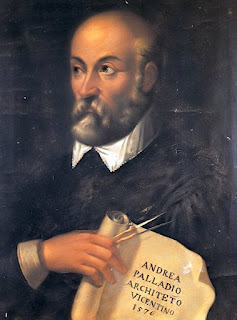The most admired architect of all time was born in Padua
 |
| Palladio became one of the most influential architects in history |
Palladio’s
style was to become so popular that architects all over the world designed
villas and public buildings copying his interpretation of classical Roman
architecture.
For
example, the White House in Washington, the home of the President of the United
States, built between 1792 and 1800, has many echoes of Palladian style.
Palladio
was born Andrea di Pietro della Gondola, either just before, or on the day, of his baptism. He was the son of a miller in Padua.
He found
work as a stone cutter in the workshop of a sculptor initially. but moved to
Vicenza when he was 16, where he joined a guild of stonemasons and
bricklayers.
It was while working as a stonemason for the poet and scholar Gian Giorgio Trissino that his career began to gather pace. Trissino not only gave him the name Palladio, after the Greek goddess of wisdom, Pallas Athene, but encouraged and helped him to study classical architecture in Rome.
Palladio became fascinated with the work of Marcus
Vitruvius Pollio, architect and engineer of the 1st century BC. It was while in
Rome that he came across the Pantheon, with its huge hemispheric dome inspired
by Vitruvius, which was to influence many of his designs.
 |
| The Villa Cornaro in Piombino Dese |
Palladio
received his first commissions in the 1530s and thereafter was in constant
demand, his style inspiring other architects outside Italy, at first in Europe
and later around the world. One factor in the spread of his fame was his
publication in 1570 of his treatise, I Quattro Libri dell'Archittetura (The
Four Books of Architecture), which set out rules others could follow.
Examples
of Palladio's work can be found all over the region where he lived and in
Venice, where he was commissioned to build, among other architectural
masterpieces, the Church of San Giorgio Maggiore, the focal point of the view
across the lagoon from St Mark's Square through the Piazzetta.
He built
a substantial number of villas for wealthy clients across the Veneto region,
some of them lining the Brenta Canal that links the lagoon of Venice with
Padua. Others such as the Villa Capra, otherwise known as La Rotonda, famous
for its symmetrically square design with four six-columned porticoes, can be
found in open countryside near Vicenza.
 |
| La Rotonda, near Vicenza, is one of Palladio's most famous buildings |
Palladio
designed two beautiful villas in the province of Padua, Villa Cornaro in
Piombino Dese and Villa Pisani in Montagnana.
One of
his finest works is considered to be Villa Foscari, otherwise known as La
Malcontenta, located next to the Brenta canal at Mira, which is between Padua
and Venice.
Palladio
died in 1580, aged 71. The cause of his death is not clear but some accounts
say he collapsed while inspecting the construction of the Tempietto Barbaro, a
church in Maser, near Treviso.
He was initially buried in a family vault in the church of Santa Corona in Vicenza, the city in which he spent most of his life, but was later re-interred at the civic cemetery, where a chapel was built in his honour.
No comments:
Post a Comment